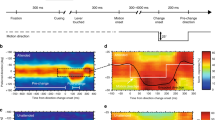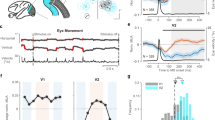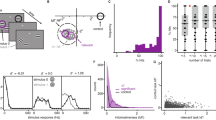Abstract
The flow of neural signals within the cerebral cortex must be subject to multiple controls as behaviour unfolds in time. In a visual discrimination task that includes a delay period, the transmission of sensory signals to circuitry that mediates memory, decision-making and motor-planning must be governed closely by ‘filtering’ or ‘gating’ mechanisms so that extraneous events occurring before, during or after presentation of the critical visual stimulus have little or no effect on the subject's behavioural responses. Here we study one such mechanism physiologically by applying electrical microstimulation1,2,3 to columns of directionally selective neurons in the middle temporal visual area4,5,6,7,8,9 at varying times during single trials of a direction-discrimination task. The behavioural effects of microstimulation varied strikingly according to the timing of delivery within the trial, indicating that signals produced by microstimulation may be subject to active ‘gating’. Our results show several important features of this gating process: first, signal flow is modulated upwards on onset of the visual stimulus and downwards, typically with a slower time course, after stimulus offset; second, gating efficacy can be modified by behavioural training; and third, gating is implemented primarily downstream of the middle temporal visual area.
This is a preview of subscription content, access via your institution
Access options
Subscribe to this journal
Receive 51 print issues and online access
$199.00 per year
only $3.90 per issue
Buy this article
- Purchase on Springer Link
- Instant access to full article PDF
Prices may be subject to local taxes which are calculated during checkout





Similar content being viewed by others
References
Salzman, C. D., Murasugi, C. M., Britten, K. H. & Newsome, W. T. Microstimulation in visual area MT: effects on direction discrimination performance. J. Neurosci. 12, 2331–2355 (1992).
Murasugi, C. M., Salzman, C. D. & Newsome, W. T. Microstimulation in visual area MT: effects of varying pulse amplitude and frequency. J. Neurosci. 13, 1719–1729 (1993).
Salzman, C. D. & Newsome, W. T. Neural mechanisms for forming a perceptual decision. Science 264, 231–237 (1994).
Dubner, R. & Zeki, S. M. Response properties and receptive fields of cells in an anatomically defined region of the superior temporal sulcus. Brain Res. 35, 528–532 (1971).
Baker, J. F., Petersen, S. E., Newsome, W. T. & Allman, J. M. Visual response properties of neurons in four extrastriate visual areas of the owl monkey (Aotus trivirgatus). J. Neurophysiol. 45, 397–416 (1981).
Van Essen, D. C., Maunsell, J. H. R. & Bixby, J. L. The middle temporal visual area in the macaque: myeloarchitecture, connections, functional properties and topographic representation. J. Comp. Neurol. 199, 293–326 (1981).
Maunsell, J. H. R. & Van Essen, D. C. Functional properties of neurons in the middle temporal visual area (MT) of the macaque monkey: I. Selectivity for stimulus direction, speed and orientation. J. Neurophysiol. 49, 1127–1147 (1983).
Albright, T. D. Direction and orientation selectivity of neurons in visual area MT of the macaque. J. Neurophysiol. 52, 1106–1130 (1984).
Albright, T. D., Desimone, R. & Gross, C. G. Columnar organization of directionally selective cells in visual area MT of macaques. J. Neurophysiol. 51, 16–31 (1984).
Treue, S. & Maunsell, J. H. R. Attentional modulation of visual motion processing in cortical areas MT and MST. Nature 382, 539–541 (1996).
Posner, M. & Petersen, S. The attention system of the human brain. Annu. Rev. Neurosci. 13, 25–42 (1990).
Desimone, R. & Duncan, J. Neural correlates of selective visual attention. Annu. Rev. Neurosci. 18, 193–222 (1995).
Moran, J. & Desimone, R. Selective attention gates visual processing in the extrastriate cortex. Science 229, 782–784 (1985).
Motter, B. C. Neural correlates of feature selective memory and pop-out in extrastriate area V4. J. Neurosci. 14, 2190–2199 (1994).
Mountcastle, V. B., Motter, B. C., Steinmetz, M. A. & Duffy, J. in Dynamic Aspects of Neurocortical Function (eds Edelman, G. M., Gall, W. E. & Cowan, W. M.) 159–193 (Wiley, New York, 1984).
Corbetta, M., Miezin, F., Dobmeyer, S., Shulman, G. & Petersen, S. Selective and divided attention during visual discrimiantions of shape, color, and speed: functional anatomy by positron emission tomography. J. Neurosci. 11, 2383–2402 (1991).
Corbetta, M., Miezin, F., Shulman, G. & Petersen, S. APET study of visuospatial attention. J. Neurosci. 13, 1202–1226 (1993).
Robinson, D. A. Amethod of measuring eye movement using a scleral search coil in a magnetic field. IEEE Trans. Biomed. Eng. 10, 137 (1963).
Cox, D. R. Analysis of Binary Data (Methuen, London, 1970).
Acknowledgements
We thank J. Groh, G. DeAngelis, G. Horwitz, D. Chen and J. Nichols for criticism of the manuscript, and J. Stein for technical assistance. We were supported by the National Eye Institute. W.T.N. is an investigator of the Howard Hughes Medical Institute.
Author information
Authors and Affiliations
Corresponding author
Rights and permissions
About this article
Cite this article
Seidemann, E., Zohary, E. & Newsome, W. Temporal gating of neural signals during performance of a visual discrimination task. Nature 394, 72–75 (1998). https://doi.org/10.1038/27906
Received:
Accepted:
Published:
Issue Date:
DOI: https://doi.org/10.1038/27906
This article is cited by
-
Attractor dynamics gate cortical information flow during decision-making
Nature Neuroscience (2021)
-
Thalamus plays a central role in ongoing cortical functioning
Nature Neuroscience (2016)
-
Neuronal firing rate, inter-neuron correlation and synchrony in area MT are correlated with directional choices during stimulus and reward expectation
Experimental Brain Research (2008)
-
Flutter Discrimination: neural codes, perception, memory and decision making
Nature Reviews Neuroscience (2003)
-
Neural basis of deciding, choosing and acting
Nature Reviews Neuroscience (2001)
Comments
By submitting a comment you agree to abide by our Terms and Community Guidelines. If you find something abusive or that does not comply with our terms or guidelines please flag it as inappropriate.



